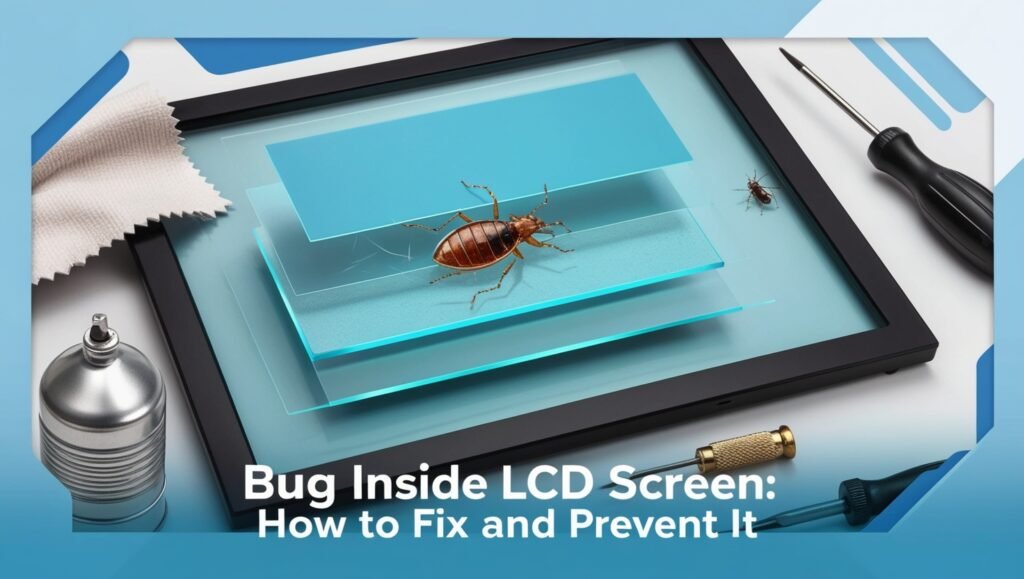Table of Contents
How to Handle a Bug Inside LCD Screen
Have you ever noticed a tiny bug trapped inside your LCD screen, crawling around and causing a distraction? It’s more common than you might think, and it can be incredibly frustrating. But don’t worry—we’ve got you covered. In this comprehensive guide, we’ll explore how to deal with a bug inside LCD screen, why it happens, and how to prevent it in the future.
Understanding the Problem: Bug Inside LCD Screen
What Causes Bugs to Get Inside LCD Screens?
LCD screens have multiple layers, and tiny gaps between these layers can sometimes allow small insects to enter. Bugs are attracted to the light and warmth emitted by electronic devices, making your screen an inviting place for them.
Types of Bugs Commonly Found in LCD Screens
- Aphids: Tiny green or black insects.
- Midges: Small flies that can fit through tiny openings.
- Ants: They can find their way into just about anything, including your screen.
Immediate Actions to Take
1. Turn Off the Screen
The first step is to turn off your device. This might encourage the bug to move towards the light source and exit the screen. It also prevents the bug from being squished and leaving marks on your screen.
2. Gently Tap the Screen
Sometimes, gently tapping the screen can dislodge the bug and encourage it to move out. Be careful not to apply too much pressure, as this can damage the screen.
3. Use a Soft Cloth
Using a soft cloth, gently wipe the screen to try and guide the bug towards the edges. Avoid using harsh materials or excessive force.
Advanced Methods to Remove Bugs
1. Disassemble the Screen
If you’re comfortable with electronics, you can disassemble the screen to remove the bug. This method requires caution and precision. Make sure to follow your device’s manual and take necessary precautions to avoid damaging the screen or voiding the warranty.
2. Use Compressed Air
Compressed air can sometimes be effective in blowing the bug out of the screen. Use short bursts and direct the air towards the edges where the bug might find an exit.
3. Professional Cleaning
If you’re unable to remove the bug yourself, consider taking your device to a professional. They have the tools and expertise to safely disassemble and clean your screen.
Preventing Bugs from Getting Inside Your Screen
1. Keep Your Environment Clean
Maintaining a clean environment can help reduce the likelihood of bugs getting inside LCD screen. Regularly clean your workspace and avoid eating near your devices.
2. Use Protective Covers
Protective covers can help shield your device from insects. Look for covers that fit snugly and have minimal gaps.
3. Avoid Leaving Devices On
Leaving devices on for extended periods can attract bugs. Turn off your devices when not in use to minimize the risk.
Dealing with Dead Bugs Inside the Screen
1. Identify the Location
If a bug has died inside your screen, it’s important to identify its exact location before attempting removal.
2. Use a Vacuum Cleaner
A vacuum cleaner with a soft brush attachment can sometimes be used to gently remove dead bugs from the edges of the screen.
3. Consult a Professional
For stubborn cases, professional help might be necessary. Technicians have specialized tools to safely remove dead bugs without damaging the screen.
Understanding the Impact on Your Device
1. Screen Damage
Bugs can cause permanent damage to your screen if they die inside and are not removed promptly. This can result in dark spots or lines on the display.
2. Warranty Considerations
Check your device’s warranty policy. Some manufacturers might void the warranty if you attempt to disassemble the screen yourself.
3. Impact on Resale Value
A screen with visible bugs or damage can significantly reduce the resale value of your device. It’s best to address the issue promptly.
Conclusion
Dealing with a bug inside LCD screen can be annoying, but it’s a problem with solutions. By taking immediate action, considering advanced methods, and following preventive measures, you can protect your device and ensure it remains bug-free. Remember to act promptly and, when in doubt, seek professional help to avoid further damage.
FAQs
1. Can bugs damage my LCD screen?
Yes, bugs can cause physical damage to the layers of your LCD screen if they get trapped inside and die.
2. How do I prevent bugs from entering my screen?
Keeping your environment clean, using protective covers, and turning off devices when not in use can help prevent bugs from entering your screen.
3. Is it safe to disassemble my screen to remove a bug?
Disassembling your screen can be risky and may void your warranty. It’s best to consult a professional if you’re unsure.
4. Will using compressed air damage my screen?
Using compressed air in short bursts can be safe, but excessive force might damage the screen. Use it cautiously.
5. Can I use insect repellent on my devices?
Insect repellents can damage electronic components. It’s better to maintain a clean environment and use physical barriers like covers.




